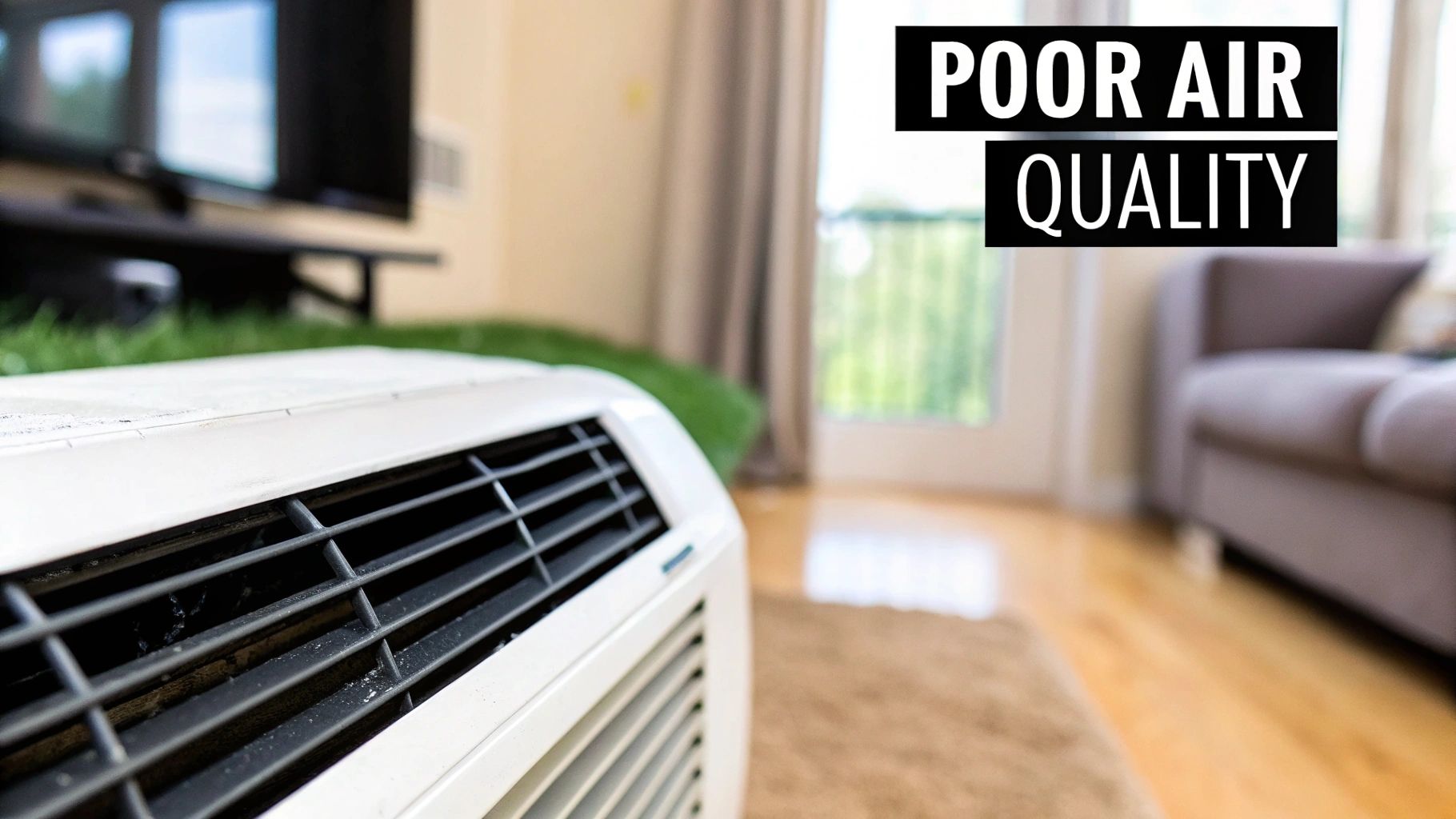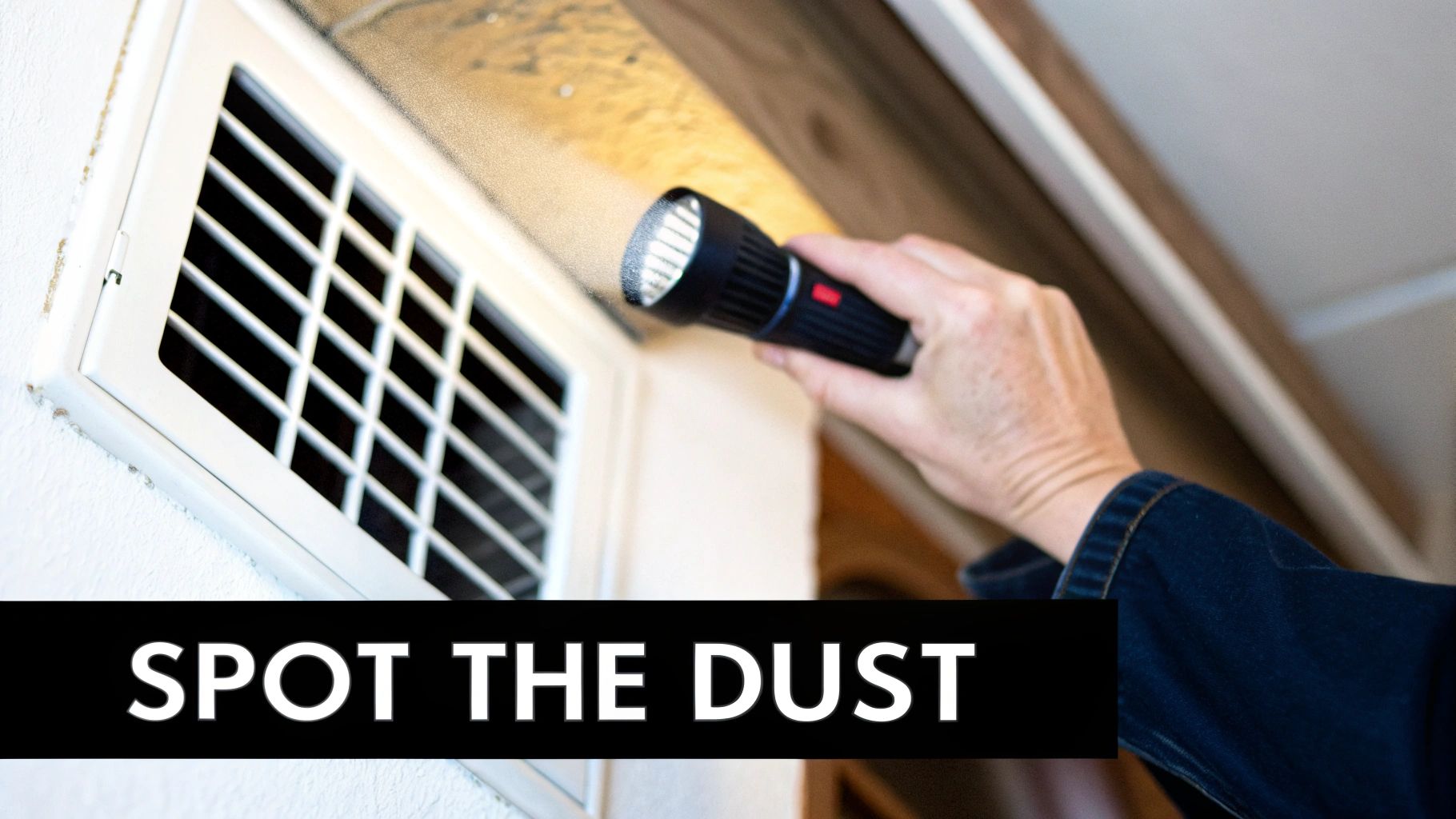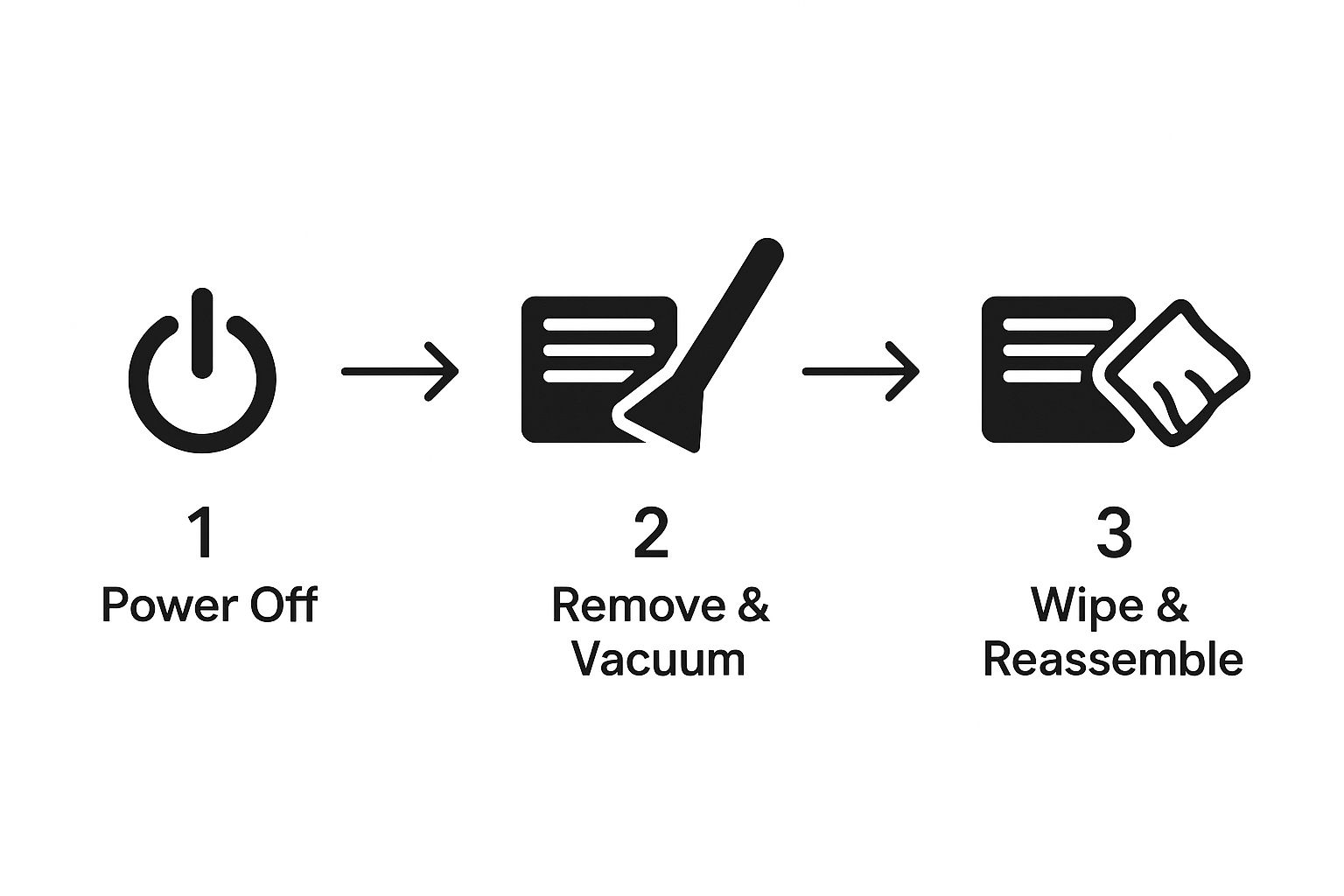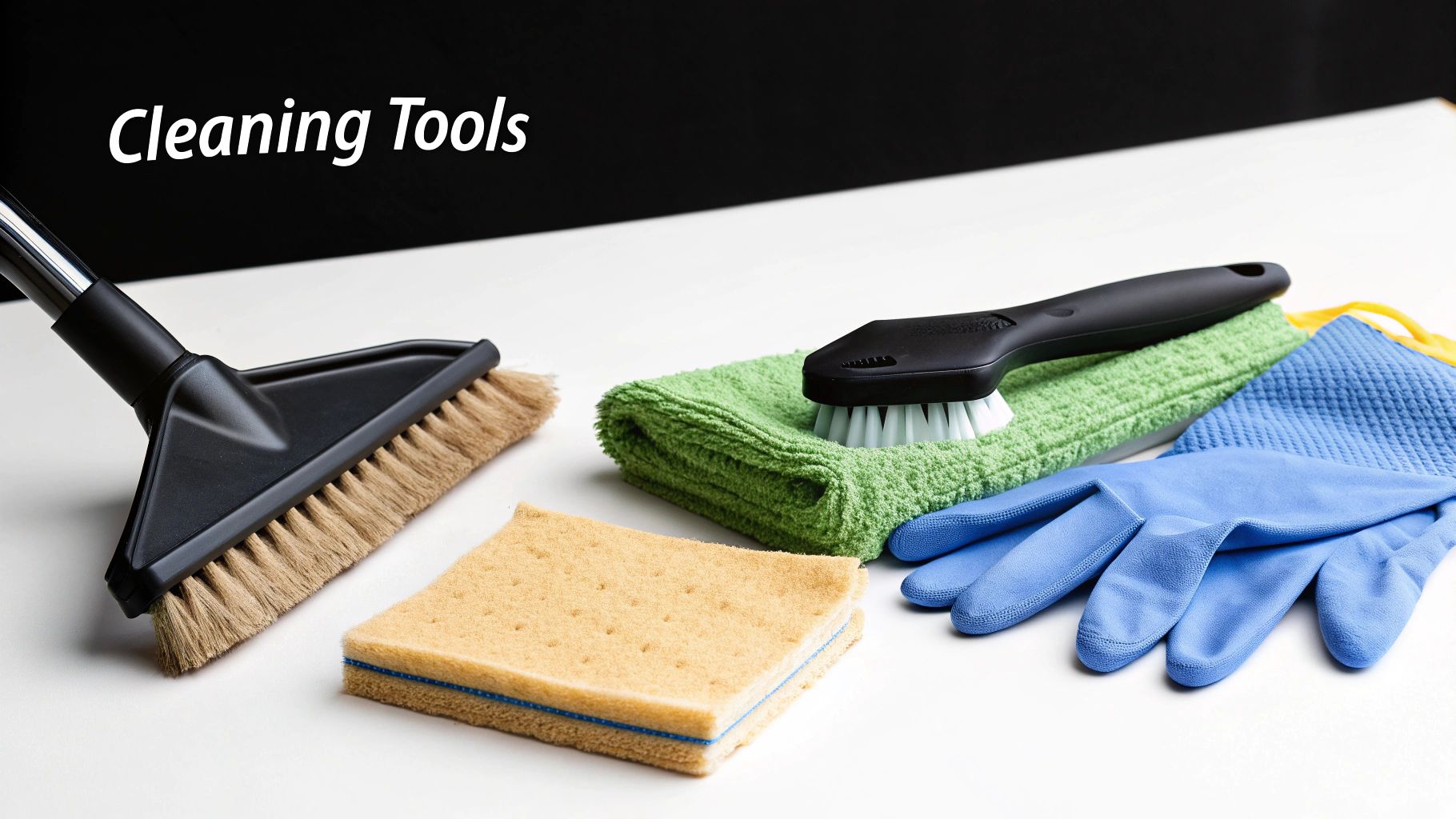That fuzzy layer of dust you see on your AC vents isn’t just unsightly—it’s a preview of what's being pushed through the air in your entire home. To clean your air conditioner vents, the process is straightforward: shut down your HVAC system, take off the vent covers for a good wash with soap and water, and give the duct opening a quick vacuum. It's a small task that makes a huge difference in your home's air quality.
Why Cleaning Your Vents Matters More Than You Think

Those vents are magnets for allergens, pet dander, and all sorts of microscopic particles that can seriously affect your family’s breathing. Every time the AC or furnace kicks on, it blasts these irritants into your living space, which can be a nightmare for anyone with allergies or asthma. If you have kids, elderly family members, or anyone with respiratory issues at home, keeping those vents clean isn't just a chore—it’s essential.
But it’s not just about health. When vents get clogged with gunk, your HVAC system has to work overtime just to move air. That strain means less efficiency and, you guessed it, higher energy bills.
The Connection Between Clean Vents and a Healthy Home
Think of your vent covers as the last line of defence for the air you breathe. Keeping them clean helps deliver some pretty great benefits:
- Fewer Airborne Allergens: Dust mites, pollen, and pet dander get trapped and removed instead of circulating endlessly.
- Better HVAC Efficiency: When air flows freely, your system runs the way it was designed to—smoothly and using less power.
- A Fresher, Cleaner-Smelling Home: Getting rid of trapped dust and potential mould growth is a direct way to tackle those stubborn, musty odours at the source.
Here in Canada, we generally recommend a full duct and vent cleaning every 3 to 5 years, especially in areas with higher humidity that can speed up the accumulation of dirt and mould. One study from a regional HVAC provider actually found that homeowners who stick to this schedule report around 30% fewer allergy-related issues.
Beyond just clearing the air of irritants, a clean indoor environment has a surprising impact on our daily lives. The quality of the air we breathe is directly tied to our well-being, and it plays a big part in designing a supportive environment for better focus and concentration.
If you’re having nagging doubts about what might be floating around in your air, you can get definitive answers by using an air quality testing kit.
Getting Your Vent Cleaning Toolkit Ready

Before you even think about unscrewing that first vent cover, let’s get our gear in order. Taking a few minutes to gather your tools now will save you from making frustrating trips back and forth later. It’s the difference between a smooth, satisfying job and a stop-and-start headache.
Your most valuable player in this game is your vacuum cleaner. But here’s the thing: not just any vacuum will cut it. You really want to use a model with a HEPA (High-Efficiency Particulate Air) filter. Why? Because a HEPA filter is designed to trap all those microscopic nasty bits like dust mites and pollen. Without one, you’re basically just kicking the dust up and sending it right back into the air you breathe.
Essential Vent Cleaning Toolkit
To tackle this project like a pro, you’ll need a few specific items. Having the right tools for the job prevents you from accidentally scratching your walls or vents and ensures you get a truly deep clean. Here's a quick checklist of what I recommend having on hand.
| Tool/Supply | Recommended Type | Purpose |
|---|---|---|
| Vacuum Cleaner | With HEPA filter | Captures fine dust particles instead of recirculating them. |
| Vacuum Attachment | Soft-bristle brush | Loosens stubborn dust without scratching surfaces. |
| Microfibre Cloths | At least two | One damp for wiping, one dry for polishing. |
| Screwdriver | Multi-bit (Phillips & flat-head) | To remove different types of vent cover screws. |
| Bucket & Soap | Mild dish soap | For washing grimy or greasy vent covers thoroughly. |
| Safety Gear | Dust mask & gloves | Protects you from inhaling dust and keeps hands clean. |
With these items ready, you'll be able to work efficiently and safely from start to finish.
For a really deep clean inside the duct opening, specialized vacuum attachments can be a game-changer. They’re built to reach further into the ductwork and pull out debris that standard attachments just can't get to.
Don't forget the simple stuff, either. A good dust mask is non-negotiable—it stops you from breathing in the very stuff you're trying to get rid of. And a pair of gloves will keep your hands from getting filthy. If you're looking to upgrade your setup, you can explore different central vacuum accessories to find tools that will make the job even easier.
A Practical Guide to Cleaning Your AC Vents
Alright, let's roll up our sleeves and get to the good part. Cleaning your AC vents is one of those simple weekend jobs that makes a real, noticeable difference in your home's air quality.
First thing's first: safety. Before you touch a single screw, head to your thermostat and turn the system off. Then, find your home's breaker box and flip the switch for the HVAC system. You absolutely do not want it kicking on while you're working.
With the power safely off, you can grab a screwdriver and start taking off the vent covers. Most are held in place with just a couple of screws. Go easy when you're prying them off to avoid leaving any marks on your walls or ceiling.
Cleaning the Covers and Duct Openings
Once the covers are off, you'll see it’s a two-part job: cleaning the grilles themselves and then clearing out the duct opening.
For the covers, a good soak in a sink full of warm, soapy water usually does the trick. If you’ve got some stubborn grime caked on, a soft brush will help get into all the nooks and crannies. Set them aside to dry completely before putting them back.
While the covers are air-drying, grab your vacuum cleaner with its soft brush attachment. Reach into the duct opening as far as you comfortably can, running the brush along the inside surfaces. Pay special attention to the corners—that's where dust bunnies love to throw a party.
This handy infographic breaks down the process visually.

As you can see, it's a straightforward flow: power down, take things apart, clean everything thoroughly, and then reassemble.
After a good vacuum, I always like to do a final pass with a damp microfibre cloth. Wring it out well so it's just barely damp, not dripping wet. This little step is amazing for catching any fine dust that the vacuum might have stirred up but didn't suck in.
Pro Tip: While you're in there, take a quick peek with a flashlight. Are there any signs of moisture, dark spots, or a musty odour? Those could be red flags for bigger issues like condensation or even mould, which definitely warrant a closer look from a professional.
This kind of surface-level cleaning is perfect for regular upkeep, but keep in mind you're only cleaning the very start of the duct run. For a true, deep clean of the entire system, the process is much more involved. You can get a better sense of what a full professional job entails in our guide on how to clean air ducts.
Once the duct openings are clean and the covers are bone-dry, just screw them back on, flip the power back on, and take a deep breath of that fresh, clean air.
Common Vent Cleaning Mistakes to Avoid

Deciding to clean your air conditioner vents yourself is a great move for better indoor air, but it's easy to make a few rookie mistakes. Honestly, knowing what not to do is half the battle.
One of the most common blunders we see is someone grabbing a chemical cleaner and spraying it right into the ducts. It feels like a quick win, but those harsh chemicals can leave a sticky film that attracts even more dust. Worse, that residue gets blown all through your house the next time the system turns on.
Using the Wrong Tools and Techniques
Another easy mistake is getting too aggressive with your tools. A stiff brush or, even worse, a metal scraper might look like it's getting the job done, but it can scratch, bend, or permanently damage the delicate fins on your vent covers.
And please, don't forget the golden rule of HVAC maintenance: kill the power at the breaker box. Just turning off the thermostat isn't enough. If the system were to kick on while your hands are in there, you could be in for a nasty surprise.
Setting Realistic Expectations
It's also important to have a clear idea of what this DIY job can and can't accomplish. Cleaning your vent covers and the duct openings you can reach is a fantastic bit of upkeep. But it’s not the same as a professional, deep duct cleaning.
Think of it this way: you’re cleaning the doorways, not the entire house. It’s a valuable job that nabs a lot of surface-level dust, but it won’t touch the kilometres of ductwork hidden in your walls and ceilings.
This kind of maintenance is a huge plus, but it won't resolve bigger problems like mould or heavy debris lurking deep inside the system. Many of these same principles apply to other systems in your home; we cover similar issues in our guide to dryer vent cleaning mistakes to avoid. Understanding the limits helps you keep your air fresh while also knowing when it’s time to call in the pros.
Knowing When to Call a Duct Cleaning Professional
Giving your vents a good wipe-down is a fantastic habit, but it’s crucial to know when a simple surface clean just won't cut it. Sometimes, the signs of a deeper problem are subtle, and other times they’re practically screaming at you. Knowing what to look for will tell you when it’s time to pick up the phone and call in the pros.
That persistent musty smell you can't seem to shake, even right after cleaning the vent covers? That's a huge red flag. It often points to moisture or even microbial growth hiding deep inside the system, far beyond where your vacuum can reach. Another classic sign is noticing dust settling back on your furniture almost immediately after you’ve cleaned. This usually means there's a serious buildup somewhere in the ducts that's getting blown back into your rooms.
Signs That Point to a Professional Clean
While your own cleaning efforts are great for maintenance, some situations demand the heavy-duty equipment and expertise of a professional. It’s probably time to call a specialist if you notice any of these issues:
- Visible Mould Growth: If you peek inside the ducts and see dark, speckled spots on the metal, that’s a clear sign of a problem that needs professional remediation, and fast.
- Unexplained Allergy Flare-Ups: Is everyone in the house suddenly sneezing, coughing, or dealing with watery eyes? It could easily be linked to allergens and contaminants being circulated by your HVAC system.
- Pest Infestations: It’s an unpleasant thought, but critters can and do make homes in ductwork. They leave behind nests, droppings, and other debris that you definitely don't want blowing into your living space.
A professional duct cleaning service goes way beyond what you can accomplish with a household vacuum. Technicians use powerful, truck-mounted vacuums and specialized agitation tools to dislodge and remove debris from the entire length of your ductwork, guaranteeing a truly comprehensive clean.
For stubborn, deeply embedded dirt or vents in hard-to-reach places, you might even need to look into professional high dusting services. Understanding the difference between regular upkeep and knowing when a deeper clean is necessary is key. You can learn more about figuring out if duct cleaning is needed for your home’s unique situation.
Answering Your Vent Cleaning Questions
Even when you've got the steps down, a few questions always come up. It's totally normal. Let's clear up some of the common ones so you can get the job done with confidence.
How Often Should I Clean My AC Vents?
Think of this in two parts. A quick wipe of the vent grilles is a great addition to your monthly cleaning schedule—it stops that first layer of dust from building up.
For the more detailed cleaning we've walked through—taking the covers off and vacuuming inside the duct opening—you’ll want to tackle that at least once a year. A perfect time to do it is just before you start cranking up the AC for the summer.
Will Cleaning My Vents Actually Help With Allergies?
Yes, it really does. Your vents are like little exit doors for all the nasty stuff that settles in your ductwork: dust mites, pet dander, and pollen that gets pulled into the system. When the AC kicks on, it shoots all of that right into your living space.
By cleaning your air conditioner vents, you're cutting off allergens at a major source. This one simple task can seriously cut down on the amount of gunk floating in your air, which often brings real relief for anyone in the house who suffers from allergies.
What’s the Real Difference Between Vent and Duct Cleaning?
This is a really important one to get straight. They sound similar, but they're two very different jobs.
- Vent Cleaning: This is what we’ve been talking about—a great DIY project. You’re focusing on the grilles themselves and as far as your vacuum hose can reach inside the duct. It’s perfect for routine maintenance.
- Duct Cleaning: This is a job for the pros. They bring in heavy-duty equipment, including powerful vacuums and specialized tools, to clean out your entire HVAC duct system, from every single vent right back to the furnace.
Basically, vent cleaning is like your regular surface tidy-up, while professional duct cleaning is the deep, whole-home detox.
If you think your home might need more than just a surface clean, the experienced technicians at Can Do Duct Cleaning can give your system a full inspection and a professional cleaning. We’ll make sure your family is breathing the cleanest, healthiest air possible. Find out more or book your service at https://www.candoductcleaning.com.


